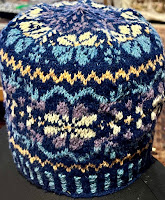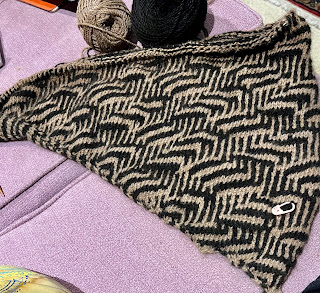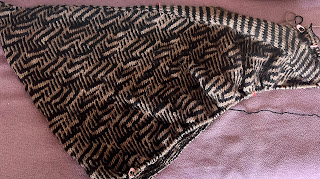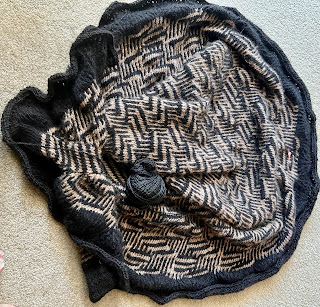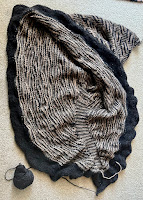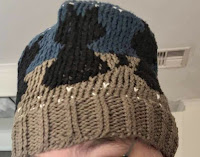Each year Shetland Wool Week has a competition for a hat design. The winning entry is made widely available, local mills produce their own colour way for the hat and all over the world knitters join in. This year's winning designer was Alison Rendall with a design called Buggiflooer, a Shetland name for Sea Campion or Silene uniflora, which grows on the rocky shores of the Shetlands. I knitted several of last year's SWW hats, in 4ply cotton that I had in abundance. This year, because The Yarn Trader, my local wool store, had a good range of Jamieson & Smith wool, I decided to try knitting their colour way for this year's hat. The Yarn Trader did not have all the exact colours, but with their help, I got fairly close.
There were challenges. The pattern controls size simply by varying needle size. I decided against knitting a swatch and opted for the smallest size needle I had in my ChiaoGoo kit - 2.75mm.
I have a small head, and I can wear the result. I've tried it on a larger head and it's fine. Ideally I think a 2.25 might produce a better size, but that's a little tight for the thickness of the wool (and also not in my kit!)
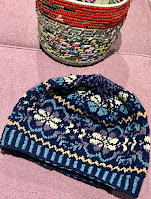 It nevertheless looks pretty good. It will be quite warm - just what you want on Shetland.
It nevertheless looks pretty good. It will be quite warm - just what you want on Shetland.
Right is the top view, modelled over the basket in the back of the photo on the left. It has a really lovely top finish. The flowers are white in nature. I think the blue and white shading works quite well.
I wanted to finish this before our next World Embroidery Study Group meeting in early December. We are talking about knitting, and a friend and I are giving a presentation on Shetland knitting.
In order to make a clear link to embroidery, I set about working the graph from this knitting pattern in cross stitch.
I used thread I already had. The closest in my stash was in the DMC Etoile range - cotton with a thread of acrylic glint.
 I ran out of the dark blue background thread part way through. Create in Stitch only had one hank in stock. It was almost enough to finish. The orange is brighter in the cotton than on the hat, and I used it as a border all around.
I ran out of the dark blue background thread part way through. Create in Stitch only had one hank in stock. It was almost enough to finish. The orange is brighter in the cotton than on the hat, and I used it as a border all around.
I finished the outer edge of the border in a slightly darker navy to get it done.
 I turned the linen into a pouch, with a cotton lining in
I turned the linen into a pouch, with a cotton lining in a similar colourway and a 5" zip.
Although not the original intention, the hat does fit inside the pouch. I’m not sure how many people would bother with this, but it might be useful when travelling.  It's a bit crazy, but I'm pleased to have worked the chart in two media. It is quite a different approach. It's easy to see why Fair Isle knitters used only two colours per row. The creation of floats on the back of the work adds to the thickness. Two threads add thickness, but not much bulk. More would increase the bulk significantly and risk tangles. When working the pattern in thread on a linen background, you can move where you choose, without carrying threads or increasing bulk. That produces more opportunities.
It's a bit crazy, but I'm pleased to have worked the chart in two media. It is quite a different approach. It's easy to see why Fair Isle knitters used only two colours per row. The creation of floats on the back of the work adds to the thickness. Two threads add thickness, but not much bulk. More would increase the bulk significantly and risk tangles. When working the pattern in thread on a linen background, you can move where you choose, without carrying threads or increasing bulk. That produces more opportunities.
It's been a satisfying project. I'm now reworking the pattern with the same wool but remixing the colours.
 It's a bit crazy, but I'm pleased to have worked the chart in two media. It is quite a different approach. It's easy to see why Fair Isle knitters used only two colours per row. The creation of floats on the back of the work adds to the thickness. Two threads add thickness, but not much bulk. More would increase the bulk significantly and risk tangles. When working the pattern in thread on a linen background, you can move where you choose, without carrying threads or increasing bulk. That produces more opportunities.
It's a bit crazy, but I'm pleased to have worked the chart in two media. It is quite a different approach. It's easy to see why Fair Isle knitters used only two colours per row. The creation of floats on the back of the work adds to the thickness. Two threads add thickness, but not much bulk. More would increase the bulk significantly and risk tangles. When working the pattern in thread on a linen background, you can move where you choose, without carrying threads or increasing bulk. That produces more opportunities.



